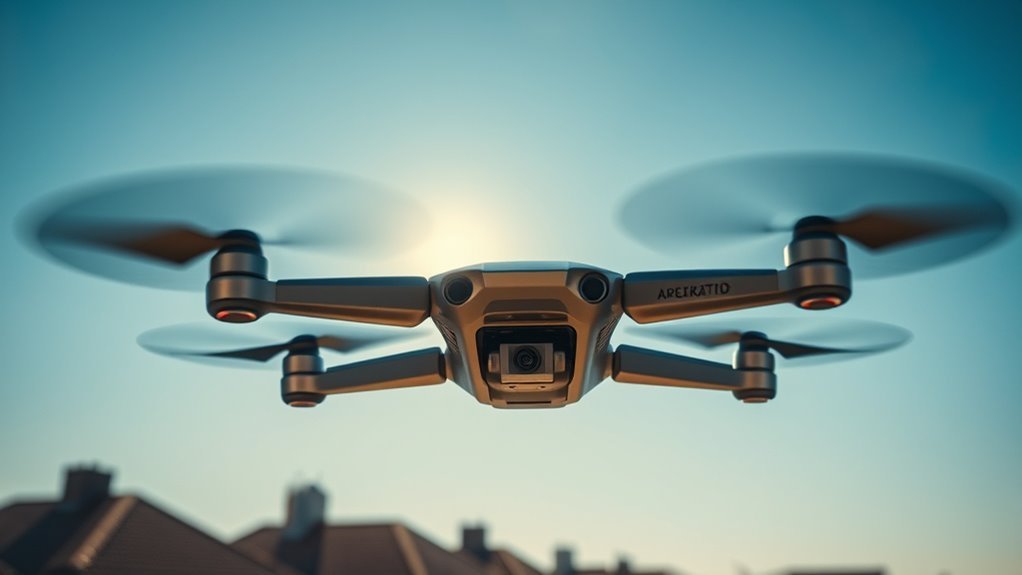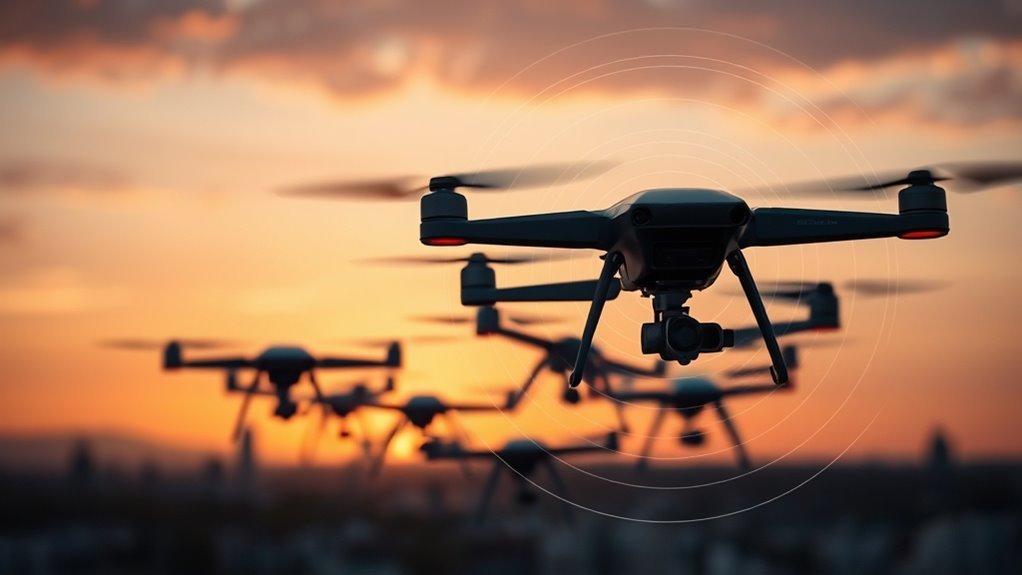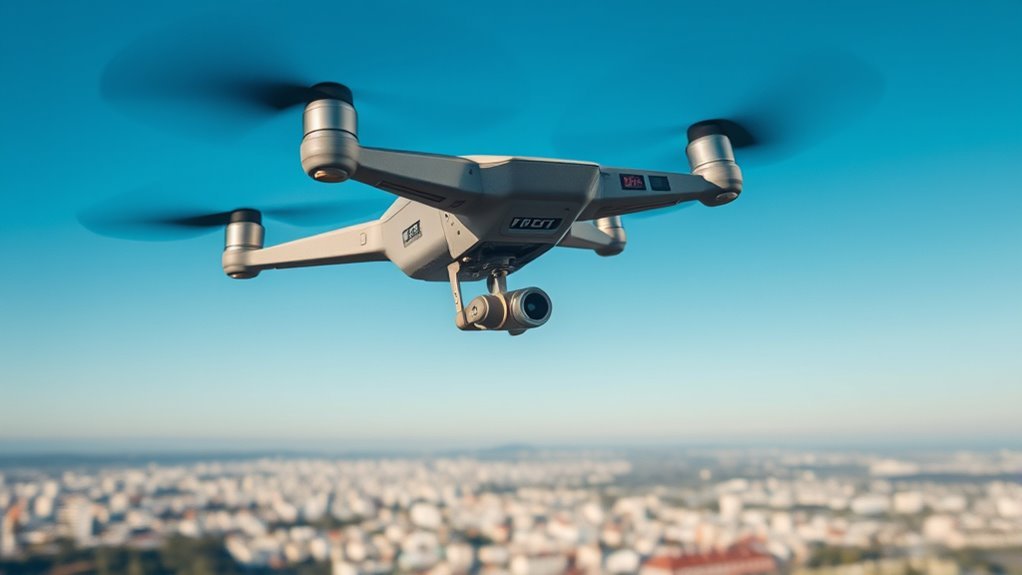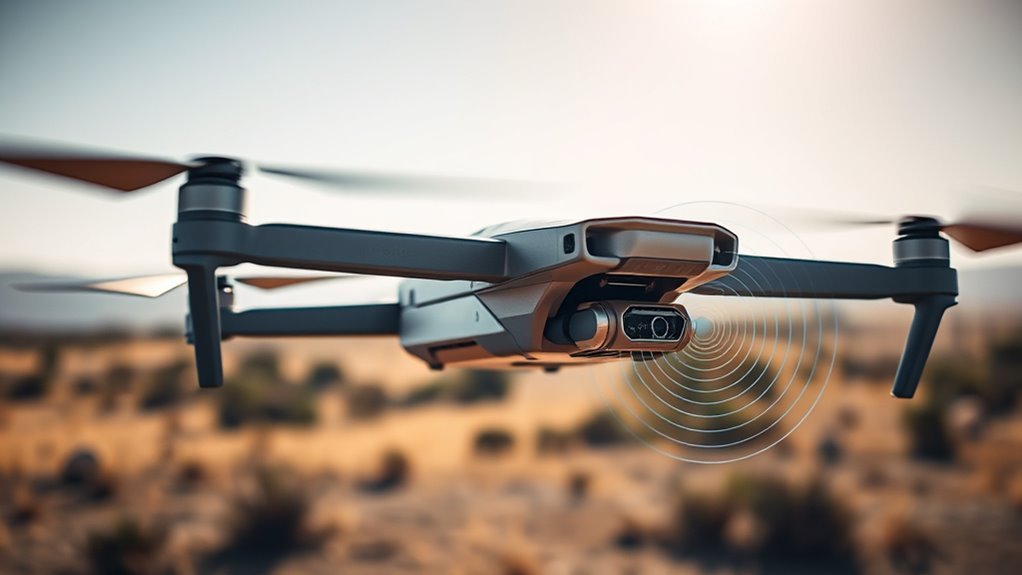Drones generate noise primarily from their rotors and motors. Various factors influence sound levels, including propeller design, motor type, and drone size. Wider blades and higher RPMs increase noise, while shallow angles can reduce it. Additionally, larger drones tend to produce louder sounds due to greater power. Flight patterns and materials used also play significant roles in noise generation. Exploring these factors will provide a deeper understanding of how to manage drone sound levels effectively.
The Basics of Drone Noise

Drone noise, often characterized by its distinct buzzing or whirring sound, primarily originates from the rotors and motors involved in flight. This drone sound is a result of complex interactions between the rotor blades and surrounding air, generating varying acoustic frequencies. The pitch and volume you perceive depend on rotor speed and design. Higher RPMs typically produce higher frequencies, while larger blades might generate lower frequencies, contributing to a deeper sound. Understanding these frequencies is essential for evaluating noise levels, especially in urban and rural settings. Drones that operate at lower acoustic frequencies can be less intrusive, allowing for a sense of freedom in outdoor spaces. Awareness of these sound characteristics can help you choose drones that align with your noise tolerance preferences.
Factors Influencing Drone Sound Levels

When it comes to drone sound levels, several key factors come into play. You’ll find that propeller design greatly affects noise production, while the type of motor you choose can alter both efficiency and sound profile. Additionally, variations in flight speed can intensify or mitigate the noise generated during operation.
Propeller Design Impact
Although many factors contribute to the sound levels produced by drones, propeller design plays a significant role in determining their acoustic signature. When you consider propeller shape, variations can greatly affect airflow and noise generation. For instance, wider blades may create more lift but can also produce higher noise levels due to increased drag. The blade angle is equally important; a steeper angle can enhance thrust but often results in a more pronounced sound signature. Conversely, shallower angles can reduce noise but might compromise efficiency. By optimizing these design elements, you can achieve a balance between performance and acoustic impact, allowing for quieter drone operation without sacrificing freedom of flight. Understanding these dynamics empowers you to make informed choices in drone design.
Motor Type Selection
Selecting the right motor type is essential in managing the sound levels of a drone, as it directly influences both performance and acoustic output. When choosing a motor, consider these factors for ideal motor efficiency and noise reduction:
- Motor Configuration: Brushless motors generally produce less noise compared to brushed motors due to their design.
- RPM Range: A motor with a lower RPM can reduce noise levels while maintaining adequate thrust.
- Torque Characteristics: Motors with higher torque can operate more efficiently, minimizing noise during flight.
- Cooling Mechanism: Efficient cooling systems can prevent overheating, ensuring the motor runs quietly and effectively.
Flight Speed Effects
Motor choice plays a vital role in how a drone behaves at different flight speeds, directly impacting noise levels. As you increase drone velocity, the rotor blades interact more aggressively with the air, intensifying aerodynamic noise. This phenomenon is essential; higher speeds often lead to increased turbulence, generating more sound. However, advancements in motor technology allow for improved efficiency and aerodynamic noise reduction, mitigating these effects. By optimizing propeller design and choosing motors that suit specific applications, you can greatly influence the overall sound profile. Understanding these drone velocity effects empowers you to balance speed and noise, ensuring your flight experience is not just efficient but also considerate of your surroundings.
Propeller Design and Its Impact on Noise

When evaluating the impact of propeller design on noise levels, it’s crucial to understand how various factors, such as blade shape and material, influence sound generation. The design of your drone’s propeller greatly affects its acoustic profile, especially when focusing on noise reduction. Here are key elements to assess:
- Blade Shape: Wider blades can produce more lift but may increase noise.
- Blade Material: Lightweight materials can reduce vibration and noise levels.
- Number of Blades: More blades can lead to smoother airflow but can also amplify noise.
- Pitch Angle: A steeper pitch can enhance performance but often results in higher noise emissions.
Motor Types and Their Acoustic Characteristics
When evaluating drone noise levels, understanding the characteristics of brushless motors is vital, as they greatly influence acoustic output. The interplay between motor design and gearbox efficiency also plays a key role in sound generation, affecting overall noise emissions. Additionally, the integration of propeller design with motor selection can further enhance or mitigate noise levels, making it essential to analyze these factors in tandem.
Brushless Motors Explained
While many enthusiasts appreciate the power and efficiency of brushless motors in drones, understanding their acoustic characteristics is essential for noise management. Brushless motors offer several advantages that can influence noise levels:
- Higher Efficiency: Brushless motors convert more electrical energy into mechanical power, reducing overall noise from wasted energy.
- Reduced Friction: With no brushes, friction is minimized, leading to quieter operation.
- Smoother Operation: The design allows for smoother rotation and minimal vibration, which lowers sound levels.
- Variable Speed Control: You can adjust speed without compromising efficiency, allowing for quieter flight modes.
Recognizing these brushless motor advantages helps you balance performance and noise, ensuring a more enjoyable flying experience while maintaining the freedom you seek.
Gearbox Influence on Noise
Understanding the impact of gearboxes on noise levels is just as important as recognizing the benefits of brushless motors. The type of gearbox you choose can greatly influence the acoustic characteristics of your drone. For instance, planetary gearboxes often provide smoother operation and improved noise reduction compared to spur gearboxes, which can generate harsher sounds due to their direct engagement. The gear ratio also plays a vital role; higher ratios can lead to increased vibrations, contributing to overall noise levels. By selecting appropriate gearbox types, you can minimize unwanted sounds, allowing for quieter flight. Ultimately, an informed decision regarding gearboxes can enhance your drone experience and guarantee you maintain that desired sense of freedom in the skies.
Propeller Design Impact
Propeller design plays an essential role in determining the noise levels of drones, greatly influenced by the type of motor employed. The interaction between propeller shape and motor characteristics directly affects sound emissions. Here are key factors to evaluate:
- Blade Shape: Wider blades can enhance lift but may increase noise.
- Pitch Angle: A higher pitch can reduce RPM, contributing to noise reduction.
- Material Composition: Softer materials tend to absorb sound better than rigid ones.
- Motor Type: Brushless motors typically operate more quietly than brushed motors.
Size Matters: How Drone Dimensions Affect Noise
As drone technology evolves, the relationship between size and noise levels becomes increasingly important, particularly for commercial and recreational users. Larger drones typically produce higher noise levels due to increased motor power and larger propellers, which generate more turbulence. Conversely, smaller drones often emit lower noise levels, making them more suitable for urban environments or noise-sensitive areas. However, this doesn’t mean small drones are always the quieter option; their rapid rotor speed can create high-frequency sounds that can be just as disruptive. Understanding drone dimensions is vital for users who value discretion and freedom in their operations. By choosing the right size, you can effectively manage noise levels while maximizing performance and functionality. Additionally, incorporating muffler technology into drone design can significantly enhance noise reduction capabilities, allowing for quieter operations in sensitive environments. Furthermore, signal attenuation can also play a role in noise levels, as the effectiveness of communication can influence flight behavior and, subsequently, sound production.
Flight Patterns and Their Role in Noise Generation
While many may focus solely on the drone’s size when evaluating noise levels, the flight patterns also play an essential role in sound generation. Different flight altitudes and maneuvering techniques can greatly influence the noise produced. Here are key factors to take into account:
Evaluating drone noise involves more than just size; flight patterns and altitudes significantly impact sound generation.
- Flight Altitude: Higher altitudes often reduce perceived noise due to distance, though this depends on terrain.
- Maneuvering Techniques: Sharp turns and sudden descents can create additional turbulence, increasing noise levels.
- Speed: Faster speeds can amplify sound due to greater air displacement.
- Hovering: Prolonged hovering generates consistent noise, often more noticeable than quick passes.
Understanding these patterns can help you minimize noise, allowing for a more discreet operation while enjoying the freedom drones provide.
Materials Used in Drone Construction
When selecting materials for drone construction, it’s essential to evaluate their impact on performance and noise levels. Lightweight drone materials, such as carbon fiber and composite plastics, enhance agility but may amplify sound due to their rigidity. On the other hand, incorporating sound-absorbing materials can mitigate noise. Foam and rubber components, for instance, can dampen vibrations and reduce the overall sound profile during operation. The choice of propellers also plays a critical role; materials that offer flexibility can lower noise signatures compared to stiff alternatives. Additionally, the size and material composition of the drone can significantly influence its radar visibility and sound levels. Ultimately, balancing durability, weight, and sound absorption will empower you to construct a drone that not only performs efficiently but also respects the tranquility of the environment around you. Additionally, understanding battery capacity is crucial, as it directly affects flight duration and performance consistency, which can influence overall noise levels during operation.
Technological Innovations for Quieter Drones
To achieve quieter drone operation, recent technological innovations have focused on advanced design modifications and enhanced materials. These developments aim for sound reduction while maintaining performance. Here are some key innovations:
- Propeller Design: Innovative blade shapes and sizes minimize turbulence, leading to quieter technology.
- Materials: Utilizing lightweight composite materials helps dampen sound vibrations and reduces overall noise.
- Active Noise Cancellation: Some drones now incorporate systems that counteract sound waves, considerably lowering perceived noise levels.
- Motor Optimization: Improved motor designs operate more efficiently and quietly, further enhancing sound reduction. Additionally, advancements in propeller design have proven crucial in minimizing aerodynamic noise, contributing to quieter drone operation.
Community Impact and Noise Regulation Considerations
Despite advancements in drone technology aimed at reducing noise, the impact on communities remains a significant concern. Community noise levels can disrupt daily life, prompting discussions around regulatory frameworks that may mitigate these effects. Understanding these frameworks is essential for balancing innovation with community needs.
| Aspect | Consideration |
|---|---|
| Community Noise | Varies based on drone frequency |
| Regulatory Frameworks | Establish guidelines for sound levels |
| Impact Assessment | Evaluate community feedback |
| Compliance Testing | Regular checks for noise limits |
| Future Innovations | Explore quieter drone designs |
As you consider the integration of drones, awareness of community noise impacts and adherence to evolving regulations is vital for fostering harmony between technology and the neighborhoods you engage with.
Frequently Asked Questions
How Does Weather Affect Drone Noise Levels During Flight?
Did you know that a 10 mph wind can increase drone noise levels by 5 decibels? Wind impact amplifies sound, while high humidity can muffle it, creating a complex relationship that affects your aerial experience.
Can Drone Noise Impact Wildlife in Natural Habitats?
Yes, drone disturbance can greatly impact wildlife in natural habitats. You’ll notice wildlife reactions vary; some species may flee or alter their behavior, affecting feeding, mating, and overall ecosystem dynamics due to noise interference.
What Are the Legal Noise Limits for Drones in My Area?
You’ll need to check local drone regulations for specific noise limits, as they vary widely. Noise complaints can lead to stricter enforcement, so understanding these laws helps guarantee you operate within acceptable sound thresholds.
How Do Different Flight Modes Affect Drone Sound?
You might think all flight modes produce the same noise, but that’s not true. Different flight mode effects alter sound frequency, resulting in varied noise levels, which can greatly impact your flying experience and surroundings.
Are There Specific Drones Designed for Low-Noise Operations?
Yes, there are silent drones specifically engineered for low-noise operations. Utilizing advanced noise reduction technologies, they minimize sound emissions, making them ideal for applications where stealth and quietness are paramount, such as surveillance or wildlife observation.

